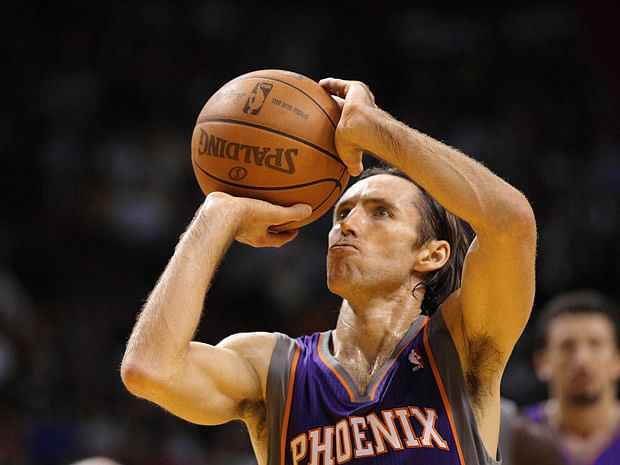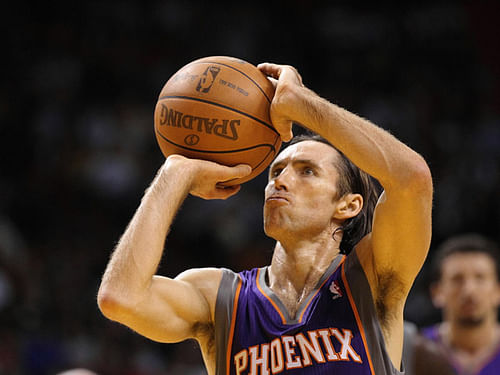
See you in Hollywood, baby

Someday, say about 20 years from now, a bunch of people are going to sit down and attempt to figure out the best NBA players in the decade spanning 2000-10. They’re going to look at career totals, per game statistics, All-Star/NBA selections…MVPs. And then they’re going to see two names. The only two dudes to win multiple MVP awards in the 2000s. Ah, they’ll say, LeBron James – one of the top ten best players ever. And then they’ll see the other name, and immediately think of sheer basketball magic.
They’ll remember a guy with long, straightened hair and intense, calculating eyes. A guy whose fingertips did things with a basketball no man had ever done before (sorry, Magic). They’ll think of the greatest moments of NBA Playoff basketball in the 2000s and then they’ll stare hard at that name in front of them: white Canadian NBA superstar, statistical anomaly, Stephen John Nash. And then they’ll smile.
Because what Steve Nash and the Phoenix Suns did for NBA basketball was, quite simply, extraordinary. No team in the 2000s was anywhere near as exciting as the Suns, and Nash was the primary reason. No team played with as much irreverence. Liberated by Coach Mike D’Antoni’s now famous seven-seconds-or-less offense, Nash and a bunch of terrific athletes like Shawn Marion and Amare Stoudemire played an offense-intensive brand of basketball that rejuvenated the league in the advanced technology era of slow paced, defense heavy teams.
In his first season with the Suns, the team poured in 110 ppg, the highest in a decade. For years, the most entertaining basketball clips on the internet involved a heavy dose of Steve Nash bling-bling followed by a thunderous Amare Stoudemire jam. He’s one of few guys to put up 50-40-90 shooting splits, and among the even fewer who have done so multiple times.
His biggest contribution to basketball, however, might be in fueling the assist’s comeback in the NBA. In the seven seasons between 2004 and 2011, he averaged at least 11 assists per game in five seasons. He’s 84 assists away from being the fifth player in NBA history to total 10000 assists. He’s made it trendy again – the next time you watch Rondo or Chris Paul weave basketball magic on the court, remember the reason.
The most exciting years for the Suns, paradoxically, were also their most heartbreaking. Nash and the Suns, despite their talent and skill, despite making it to the playoffs every year in the first four after Nash’s arrival, never made it past the Conference Finals. The reason? Tim Duncan and the San Antonio Spurs – possibly the most riveting rivalry in the last decade. The absolute low point was in Game 1 of the WC semi-finals in 2008, when Timmy drained a buzzer-beating three pointer to send the game into overtime and eventually win it for the Spurs. The Spurs won it all in 2003, ‘05 and ’07 – breaking the spirit of a tough Suns team in some playoff round each time.
After the 2008-09, after years of playoff futility, everything changed. Mike D’Antoni, and his patent offense packed up their bags and left for New York. And the Suns proceeded to miss the playoffs for the first time since Nash’s arrival. It looked like the good ol’ days were over. The most exciting, swashbuckling, adrenaline pumping team in the team was about to have its back broken. The greatest point guard of this generation was not going to win an NBA title. The thing was, they’d forgotten to tell Nash that his window had closed.
A 35 year old Nash (THIRTY FIVE!!) led the Suns to a Cinderella season, carrying them to the WCF against the defending champions, the LA Lakers. In an intense Game 5, both teams having split the first four games, Ron Artest (now Metta World Peace) hit a buzzer beating trey to win it for the Lakers. The Lakers won the series in six, and then the NBA championship. Another three pointer. Another year down the drain. Championship dreams in tatters.
He’s 38 now. He isn’t the player he once was, offensively. He still averaged over 10 assists a game for a Suns team that almost made the playoffs last year. He’s stoically refused to request for a trade to a contending team in the last three years, despite fans in Phoenix begging the management to trade him, the face of the franchise, because he deserved one shot at the ultimate gold, a shot he gave Phoenix for years on end.
He’s going to get it now. He’s going to Laker-land, the house of purple and gold. He’s going to the basketball home of the last point guard of his ilk, Magic Johnson. He’s going to play with the greatest player of his generation, a guy picked within two spots of him in the same NBA draft that made them professionals. A guy who is chasing another dream, another accomplishment.
Steve Nash is going to Hollywood now, and he’s shooting for gold.